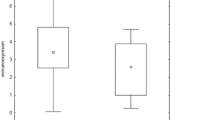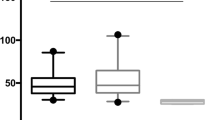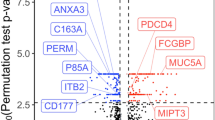Abstract
Calgranulin B is a small calcium-binding protein with several immunological functions mainly involved in chronic inflammation and cancer. It can participate in recruitment of neutrophils and leukocytes in inflamed tissue, oxidant/antioxidant balance, adhesion of neutrophils to fibronectin, and regulation of apoptosis. In a previous proteomic study, we found that calgranulin B was up-regulated in the bronchoalveolar lavage (BAL) of patients with idiopathic pulmonary fibrosis (IPF) with respect to controls and patients with other interstitial lung diseases. The aims of this study are to compare calgranulin B concentrations in BAL of patients with IPF and sarcoidosis and controls by a quantitative method, to look for correlations with clinical data, and to evaluate calgranulin B expression in lung tissue of IPF patients by immunohistochemistry. A modification of a commercial ELISA was used to determine calgranulin B concentrations in BAL of 16 patients with IPF (a group of patients in which we previously performed proteomic analysis), 17 patients with sarcoidosis, and 7 controls. The immunohistochemistry was done in a subgroup of patients with IPF and a control group of lung transplant donors. Calgranulin B concentrations were significantly higher in patients with IPF than controls (p < 0.01); they were inversely correlated with FVC and DLCO values and directly correlated with neutrophil and eosinophil percentages in BAL. Immunohistochemistry revealed a patchy distribution of calgranulin B, predominantly around areas of fibrotic remodeling. Calgranulin B may be a trigger molecule involved in the evolution and progression of IPF, being overexpressed in BAL of patients with IPF with severe functional deterioration and in the peribronchiolar area bordering zones of honeycombing.



Similar content being viewed by others
Abbreviations
- BAL:
-
bronchoalveolar lavage
- ILD:
-
interstitial lung diseases
- 2-DE:
-
two dimensional electrophoresis
- IPF:
-
idiopathic pulmonary fibrosis
References
Foell, D., H. Wittkowski, T. Vogl, and J. Roth. 2007. S100 proteins expressed in phagocytes: A novel group of damage-associated molecular pattern molecules. Journal of Leukocyte Biology 81: 28–37.
Lagasse, E., and R.C. Clerc. 1988. Cloning and expression of two human genes encoding calcium-binding proteins that are regulated during myeloid differentiation. Molecular and Cellular Biology 8: 2402–2410.
Roth, J., S. Teigelkamp, et al. 1992. Complex pattern of myelo-monocytic differentiation antigens MRP8 and MRP14 during chronic airway inflammation. Immunobiology 186: 304–314.
Lorenz, E., M.S. Muhlebach, P.A. Tessier, et al. 2008. Different expression ratio of S100A8/A9 and S100A12 in acute and chronic lung diseases. Respiratory Medicine 102: 567–573.
Ryckman, C., K. Vandal, P. Rouleau, et al. 2001. Proinflammatory activitiesof S100: Proteins S100A8, S100A9 and S100A8/A9 induce neutrophil chemotaxis and adhesion. Journal of Immunology 166: 4678–4688.
Gebhardt, C., J. Nemeth, P. Angel, and J. Hess. 2006. S100A8 and S100A9 in inflammation and cancer. Biochemical Pharmacology 72: 1622–1631.
Foell, D., and J. Roth. 2004. Proinflammatory S100 proteins in arthritis and autoimmune diseases. Arthritis and Rheumatism 50: 3762–3771.
Kosaki, A., T. Hagegawa, T. Kinura, et al. 2004. Increased plasma S100A12 levels in patients with type 2 diabetes. The Journal of Clinical Endocrinology and Metabolism 89: 5423–5428.
Odink, K., N. Cerletti, J. Bruggen, et al. 1987. Two calcium-binding proteins in infiltrate macrophages of rheumatoid arthritis. Nature 330: 80–82.
Haga, H.J., J. Brun, H.B. Berntzen, et al. 1993. Calprotectin in patients with SLE: Relation with clinical and laboratory parameters of disease activity. Lupus 2: 47–50.
Schnekenburger, J., V. Schick, and B. Kruger, et al. 2008. The calcium-binding protein S100A9 is essential for pancreatic leukocyte infiltration and induces disruption of cell–cell contacts. Journal of Cellular Physiology 216: 558–567.
Yoo, B.C., Y.K. Shin, S.B. Lim, et al. 2008. Evaluation of calgranulin B in stools from the patients with colorectal cancer. Diseases of the Colon & Rectum 51: 1703–1709.
Heizmann, C.W., G.E. Ackermann, and A. Galichet. 2007. Pathologies involving S100 proteins and RAGE. Subcellular Biochemistry 45: 93–138.
Wilkinson, M.M., A. Busuttil, C. Hayward, et al. 1988. Expression pattern of related cystic fibrosis-associated calcium-binding proteins in normal and abnormal tissues. Journal of Cell Science 91: 221–230.
Pederson, S.K., A.J. Sloane, S.S. Prasad, et al. 2005. An immunoproteomic approach for identification of clinical biomarkers formonitoring disease: Application to cystic fibrosis. Molecular & Cellular Proteomics 4: 1052–1060.
Gray, R.D., G. Macgregor, D. Noble, et al. 2008. Sputum proteomics in inflammatory and suppurative respiratory diseases. American Journal of Respiratory and Critical Care Medicine 178: 444–452.
Longbottom, D., J.M. Sallenave, and V. van Heyningen. 1992. Subunit structure of calgranulin A and B obtained from sputum, plasma, granulocytes and cultured epithelial cells. Biochimica et Biophysica Acta 1120: 215–222.
Foell, D., T. Kucharzik, and M. Kraft. 2003. et al Neutrophil-derived human S100A12 is strongly expressed during chronic active inflammatory bowel disease. Gut 52: 847–853.
Magi, B., L. Bini, M.G. Perari, et al. 2002. Bronchoalveolar lavage fluid protein composition in patients with sarcoidosis and idiopathic pulmonary fibrosis: A two dimensional electrophoretic study. Electrophoresis 23: 3434–3444.
Rottoli, P., B. Magi, M.G. Perari, S. Liberatori, et al. 2005. Cytokine profile and protome analysis in broncoalveolar lavage of patients with sarcoidosis, pulmonary fibrosis associated with systemic sclerosis and idiophatic pulmonary fibrosis. Proteomics 5: 1423–1430.
Bargagli E, C Olivieri, A Prasse, et al. 2008. Calgranulin B in BAL of patients with interstitial lung diseases. Inflammation 31: 351–354.
Magi, B., E. Bargagli, L. Bini, and P. Rottoli. 2006. Proteome analysis of bronchoalveolar lavage in lung diseases. Proteomics 6(23): 6354–6369.
American Thoracic Society ATS. 2002. Society, ERS. International multidisciplinary consensus classification of the idiopathic interstitial pneumonias. American Journal of Respiratory and Critical Care Medicine 165: 227–304.
Hunninghake, G.W., U. Costabel, M. Ando, et al. 1999. ATS/ERS/WASOG statement on sarcoidosis. Sarcoidosis, Vasculitis, and Diffuse Lung Diseases 16: 149–173.
Ziegenhagen, M.W., M.E. Rothe, and M. Schlaak. 2003. Muller-Quernheim: BAL and serologial parameters reflecting the severity of sarcoidosis. The European Respiratory Journal 21: 407–413.
Hunninghake, G.W., S. Gilbert, R. Pueringer, et al. 1994. Outcome of the treatment of sarcoidosis. American Journal of Respiratory and Critical Care Medicine 149: 893–898.
Bargagli, E., C. Bigliazzi, A. Leonini, N. Nikiforakis, M.G. Perari, and P. Rottoli. 2005. Tryptase concentrations in bronchoalveolar lavage from patients with chronic eosinophilic pneumonia. Clinical Science (London) 108(3): 273–276.
Bargagli, E., M. Margollicci, M. Perrone, A. Luddi, N. Bianchi, L. Volterrani, M.G. Perari, S. Grosso, and P. Rottoli. 2007. Chitotriosidase levels in BAL of patients with sarcoidosis. Sarcoidosis, Vasculitis, and Diffuse Lung Diseases 24: 59–64.
Bradford, M.M. 1976. A rapid and sensitive method for the quantification of microgram quantities of protein utilizing the principle of protein-dye binding. Analytical Biochemistry 72: 248–254.
Selman, M., T.E. King, A. Pardo, et al. 2001. Idiopathic pulmonary fibrosis: Prevailing and evolving hypotheses about its pathogenesis and implications for therapy. Annals of Internal Medicine 134: 136–151.
Hallgren, R., L. Bjermer, R. Lundgren, and P. Venge. 1989. The eosinophil component of the alveolitis in idiophatic pulmonary fibrosis. Signs of eosinophil activation in the lung are related to impaired lung function. The American Review of Respiratory Disease 139: 373–377.
Kuwano, K., N. Nakashima, I. Inoshima, et al. 2003. Oxidative stress in lung epithelial cells from patients with idiopathic interstitial pneumonias. The European Respiratory Journal 21: 232–240.
Veeraraghavan, S., P.I. Latsi, A.U. Wells, et al. 2003. BAL findings in NSIP and UIP. The European Respiratory Journal 22: 239–244.
Anceriz, N., and K. Vandal. 2007. Tessier P.A. S100A9 mediates neutrophil adhesion to fibronectin to activation of beta2-integrins. Biochemical and Biophysical Research Communications 354: 84–89.
Queisser, M.A., F.M. Kouri, M. Konigshoff et al. 2008. Loss of RAGE in pulmonary fibrosis: Molecular relations to functional changes in pulmonary cell types. American Journal of Respiratory Cell and Molecular Biology. Epub.
Englert, J.M., L.E. Hanford, N. Kaminski, J.M. Tobolewski, R.J. Tan, C.L. Fattman, L. Ramsgaard, T.J. Richards, I. Loutaev, P.P. Nawroth, M. Kasper, A. Bierhaus, and T.D. Oury. 2008. A role for the receptor for advanced glycation end products in idiopathic pulmonary fibrosis. The American Journal of Pathology 172(3): 583–591.
He, M., H. Kubo, K. Ishizawa, A.E. Hegab, Y. Yamamoto, H. Yamamoto, and M. Yamaya. 2007. The role of the receptor for advanced glycation end-products in lung fibrosis. American Journal of Physiology. Lung Cellular and Molecular Physiology 293(6): L1427–L1436.
Morbini, P., C. Villa, I. Campo, M. Zorzetto, S. Inghilleri, and M. Luisetti. 2006. The receptor for advanced glycation end products and its ligands: A new inflammatory pathway in lung disease? Modern Pathology 19(11): 1437–1445.
Fernández Pérez, E.R., C.E. Daniels, et al. 2009. Incidence, prevalence, and clinical course of idiopathic pulmonary fibrosis: A population-based study. Chest.
Kottmann, R.M., C.M. Hogan, R.P. Phipps, and P.J. Sime. 2009. Determinants of initiation and progression of idiopathic pulmonary fibrosis. Respirology 14: 917–933.
Zappala, C.J., P.I. Latsi and A.G. Nicholson, et al. 2009. Marginal decline in FVC is associated with a poor outcome in IPF. European Respiratory Journal.
Acknowledgments
The authors thank Dr. Spina, Dr. Bini, and Dr. Magi for their help.
Author information
Authors and Affiliations
Corresponding author
Rights and permissions
About this article
Cite this article
Bargagli, E., Olivieri, C., Cintorino, M. et al. Calgranulin B (S100A9/MRP14): A Key Molecule in Idiopathic Pulmonary Fibrosis?. Inflammation 34, 85–91 (2011). https://doi.org/10.1007/s10753-010-9210-7
Published:
Issue Date:
DOI: https://doi.org/10.1007/s10753-010-9210-7




